by Randy J. Guliuzza, P.E., M.D., and Aaron T. Guliuzza, P.E.*
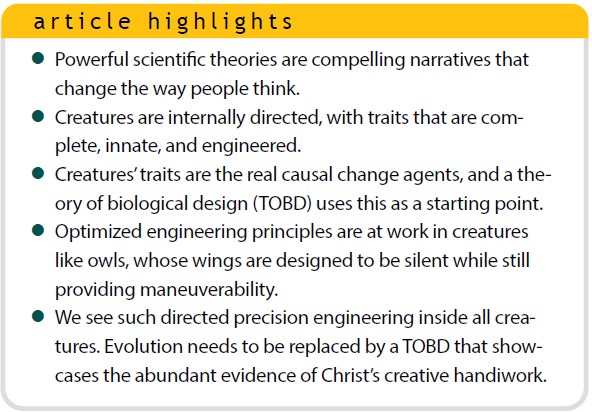
If the greatest writers had been well-versed in fields of science, then history might have also remembered them as eminent scientific theorists. Hallmarks of excellent writing like simplicity, soundness, wit, and intrigue wrapped in a lucid style make for an engaging story, which, time has revealed, is the backbone of powerful scientific theories. Influential theories can change a perspective about some simple observation that’s then extrapolated into a compelling narrative that radically transforms the way people think about life.
Splendid Narratives Filled with Silly Science
Evolutionary biologist Richard Dawkins is the best example of a popular science writer who has conveyed a widely influential theory—namely, his “selfish gene” theory of evolution. The science journal Nature applauded Dawkins’ landmark 1976 book The Selfish Gene on the thirtieth anniversary of its publication. He wasn’t lauded for making a discovery. Instead, his “landmark work” was narrating “a vivid and systematic picture of biological evolution wholly ‘from the point of view of the gene’ and explor[ing] the wider implications of this approach.”1
Can simply changing a “point of view” be powerful? Absolutely. Great Britain’s Royal Society conducted a public poll in 2017 to identify “the most inspiring science books of all time.”2 The Selfish Gene was deemed the most inspiring science book ever, “followed by Bill Bryson’s 2003 book A Short History of Nearly Everything in second place, and Charles Darwin’s 1859 classic On the Origin of Species in third place…with many commenting on how [The Selfish Gene] had changed their perspective of the world.”2
It’s notable that Darwin and Dawkins hold up an organism and basically say, “Starting today, think about creatures from a new perspective in light of the following story.” Both present a profoundly diminished view of creatures compared to the high esteem in which they were previously held. The Origin of Species began depicting creatures as never-ending works-in-progress that nature cobbles together in a clunky, purposeless process. They’re passive modeling clay whose random genetic mistakes are sorted through by the vicissitudes of nature.3 Dawkins adds,
We are survival machines—robot vehicles blindly programmed to preserve the selfish molecules known as genes. This is a truth which still fills me with astonishment.... One of my hopes is that I may have some success in astonishing others.1
In spite of the hype, selfish-gene theory and selectionism don’t help us understand the operation of creatures any better. Neither has offered noteworthy testable predictions, a useful way to characterize biological function, or guided research toward valuable discoveries. This article will demonstrate how we can do far better by applying a powerfully contrasting perspective of creatures within the new theory of biological design (TOBD).
A Changed Perspective with a Theory of Biological Design
Clearly, the way we think about creatures is extremely important. The radically different approach of a TOBD is long overdue. The essential change in view is that it is organism-focused. Causal explanations are framed according to engineering practice.
Organism-focused (or internalism) means that all of an organism’s capabilities are determined by innate, engineered, and up-front traits. These exist in organisms prior to any environmental exposures. These capabilities should be the principle focus of research and discussion. Traits—not exposures—determine capabilities. Causal explanations should credit these traits with a creature’s successful resolutions of environmental challenges.
An engineering-based approach fosters testable predictions. Some are: purpose is expected at every level of investigation, biological functions can be reversed engineered, and identifiable control systems will govern 100% of an organism’s operations. It expects to find corresponding features between human-engineered contrivances and those in creatures that perform similar functions. Engineered outcomes like efficiency, optimization, robustness, etc. should be widely evident. Biological functions will be most accurately explained by models developed using engineering principles. These principles should guide research since they’re essential for making correct cause-and-effect associations.
In sound scientific theories, assumptions often also function as expectations (i.e., testable predictions). The assumptions detailed above flow from the engineering discipline and are scientifically plausible.
A TOBD hypothesizes that the most likely reason creatures look engineered is that they are engineered. In other words, a TOBD is neither a conclusion nor an inference to the best explanation. A TOBD rejects selectionism’s inherent mystical narrative gloss and personifications. The ability to confirm the TOBD’s hypothesis and assumptions by observation/testing makes it scientifically superior to both selfish-gene theory and selectionism.
As an example, let’s apply a TOBD to a really challenging biological activity like the silent flight that owls can accomplish. One goal of engineers is optimization. So, if owls were engineered for silent flight, then
1. Do we find optimization?
2. If so, can it be explained by drawing on engineering principles from disciplines like fluid mechanics, material science, acoustics, and aerodynamics?
3. Do we see corresponding features between an owl’s traits and human-engineered devices?
4. Do engineering principles help us better understand biology?
Owl Wing Acoustics: Feathers Optimally Engineered for Silence
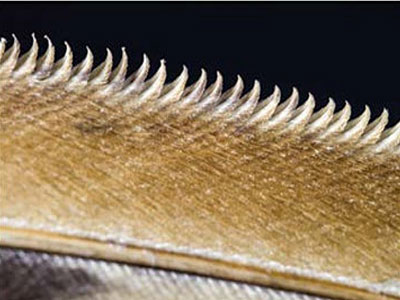
Is owl flight optimized for silence? It seems so. Owl researchers stated,
As the flight of owls is so silent that the available microphones are at their limits…it will be a challenge for the future to develop a set-up in which absolute noise production of owl flight can be measured.4
They added that an owl could glide 10 feet from a human and not be heard. The system appears to be optimized to the limits of physical sound detection. Owls use other sophisticated avionics in flight that rely on their hearing, thus they may not be able to hear their own flight.
Air flowing over wings acts like a fluid such as water flowing over fins or around a rudder. To account for an owl’s silent flight, fluid mechanic engineers study the interactions of fluids and structures that explain sound production from turbulent or laminar (uniform) air flowing over a wing. Their experiments demonstrate that sounds produced by feathers can be reduced with any one of three aerodynamic features: leading edge serrations, velvety feathers, and trailing edge “fringe.”5
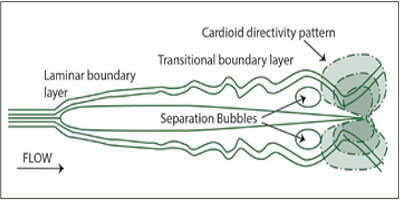
Owls are the only birds known to have functional leading-edge serrations. A serration is a precisely curved, comb-like projection on the feather (see Figure 1). Since a TOBD assumes purpose that can be reverse engineered at every level of biology, the search for the aerodynamic purpose of leading-edge serrations serves as a guide for identifying the engineering principles that are predicted to explain how the serrations work.
Aeroacoustics is a fluids-engineering subspecialty that studies the noise fluids make. Researchers have learned that air flowing close to a wing, known as a boundary layer, is initially very smooth. But the smooth layer of air eventually starts to break away from the wing. The result is flow separation and eventually separation bubbles (Figure 2). The separation bubbles cause an area of low pressure behind the wing that tends to pull the wing back in a phenomenon called drag. The bubbles also create sound.6 Flow separation occurs more prevalently the steeper the angle of the wing is relative to the ground (a high angle of attack) and at low airspeeds.
.jpg)
Fluids engineers have discovered that adding structures known as vortex generators to the leading edge of an aircraft wing, wind turbine blade, or submarine plane greatly reduces flow separation, bubbles, drag, and noise.7 These engineers also research the optimal shape, positioning, and numbers of vortex generators for specific applications. They’ve used these to improve the angle of attack that an aircraft can fly before stalling.7,8
Flying at low speeds and high angles of attack characterizes owl flight. Owl leading edge serrations operate by the same principles as human-engineered vortex generators. The serrations swirl the boundary layer of air, preventing boundary layer separation and minimizing emitted noise. Engineers describe these leading-edge serrations “as a set of closely spaced co-rotating vortex generators that reduce the flight noise emitted by the owl.”9 This confirms a TOBD prediction of finding corresponding features between human-engineered devices and those in creatures that perform similar functions.
Trailing edge “fringe” also helps keep the boundary layer of air close to the wing by channeling the air into streamlined paths at the point where the airflow leaves the wing, reducing sound.10 Engineers use trailing edge serrations on wings where noise is a problem, such as with drones and wind turbine blades as seen in Figure 3.
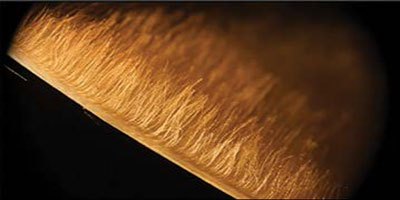
Feathers themselves are semirigid, and their movements on the wing create another source of noise. Velvety feathers midway along the main wing surface reduce the sound produced by the friction of each feather sliding over the next (Figure 4).4
Owl Wing Aerodynamics: Optimally Engineered for Slow, Stalled, Silent Flight
The main characteristic of an optimized solution is that it is the best balance of many competing needs. In a kind of trade-off, any one particular need may not be optimized for its highest efficiency, but the combination of how everything works together is the best possible arrangement given all constraints. Aircraft noise can be audible for thousands of feet, and even the best engineers struggle to find the optimal solution between quietness and economic efficiency (Figure 5).
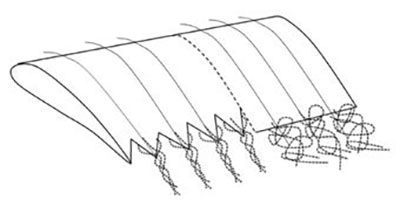
Does this mean the optimization of the owl’s sound-reducing features produces flight inefficiencies elsewhere? Not at all. The genius engineering of leading-edge serrations, velvety feathers along the main wing surface, and trailing edge fringe enhances the flight characteristic that owls specialize in—controlled, stalled flight.4
This optimum balance for super-slow flight is a function of the wing area to body mass ratio. When compared to other birds,
The wings of barn owls are huge in relation to body mass…. Thus, the geometry of the barn owl wing shows an indirect adaptation towards silent flight by being optimized for low flight velocities…. A major disadvantage of low flight velocities is the increased influence of induced drag, which negatively affects the flight performance. The general shape of owl wings is suited to reducing this influence, either by an overall elliptical shape, which is especially prominent for barn owls, or by the expression of slotted wings due to feather emarginations [notched margins].4
Aerospace engineers call wing shape design “planform.” They can specify elliptical, rectangular, tapered, pointed, swept, or hybrid designs. Owls have elliptical wings. Why? Aerospace engineers describe elliptical as “the ideal subsonic planform since it provides for a minimum of induced drag for a given aspect ratio…. The elliptical wing provides the best coefficients of lift before reaching an incipient stall.”12
Splendid Narrative, Solid Science, and a True View of Creatures

Scientific theories are narratives that can change a point of view about natural phenomena. This can be powerful. Without ever leveling a direct attack against God, Darwin’s devalued view of God’s living handiwork led to a cheapened view of Him…and widespread disbelief in His work in creation.13 Little wonder Harvard’s esteemed evolutionary theorist Stephen Jay Gould said, “Darwinian natural selection presents the most contrary position imaginable” to beliefs of “an omnipotent and benevolent creator who loves us most of all.”14
A theory of biological design presents a radically different way to look at creatures. Its essential changes in perspective are:
- A TOBD is organism-focused, not environment-centered.
- Causal explanations become engineering-based.
- It takes an engineer’s approach to research that’s characterized by objectivity, clarity, and precision.
- The narrative is compelling because it always describes breathtaking engineering—as in owl flight that’s optimized for silence and aerodynamics.
A TOBD is exactly what biology needs to reverse the imaginative stories rooted in Darwinian selectionism. Scientifically, the two narratives are not even in the same league. A TOBD’s objective assumptions counter evolution’s mysticism (e.g., genes that act like selfish agents—seriously?). It presents the opposite view of creatures to selectionism.
A TOBD holds up living organisms and says, “Starting today, think about creatures as active, problem-solving entities with the innate capability to solve many challenges and fill the earth.” Organisms are neither fixer-uppers nor unending works-in-progress. They are already complete and have been from the beginning.
At ICR, we believe that worship should be the normal response to science. Biology isn’t a mess; it’s a masterpiece. That high view of creatures leads to an exalted view of the Lord Jesus Christ, who made owls. “The beast of the field shall honour me, the dragons and the owls” (Isaiah 43:20, KJV).
References
- Sperber, D. 2006. Evolution of the Selfish Gene. Nature. 441: 151–152.
- The Selfish Gene Tops Royal Society Poll to Reveal the Nation’s Most Inspiring Science Books. The Royal Society News. Posted on royalsociety.org July 19, 2017.
- Guliuzza, R. 2017. Adaptability Via Nature or Design: What Evolutionists Say. Acts & Facts. 46 (9): 17–19.
- Wagner H. et al. 2017. Features of Owl Wings That Promote Silent Flight. Interface Focus. 7 (1).
- Johnson, J. J. S. Cities Are Quieter Now, But Not Silent as Owls. Creation Science Update. Posted on ICR.org April 29, 2020.
- Arcondoulis, E. et al. 2010. A Review of Trailing Edge Noise Generated by Airfoils at Low to Moderate Reynolds Number. Acoustics Australia. 38 (3): 129–133.
- Lin, J. 2002. Review of Research on Low-Profile Vortex Generators to Control Boundary-Layer Separation. Progress in Aerospace Sciences. 38 (4–5): 389–420.
- Zyga, L. Scientists Discover Second Purpose for Vortex Generators. Posted on phys.org September 13, 2012.
- Geoffrey, L. 1998. A Study of the Silent Flight of the Owl. 4th AIAA/CEAS Aeroacoustics Conference. AIAA paper 98-2340.
- Avallone, F. et al. 2018. Noise Reduction Mechanisms of Sawtooth and Combed-Sawtooth Trailing-Edge Serrations. Journal of Fluid Mechanics. 848: 560–591.
- De Alvear Cardenas, J. I. et al. 2018. Silentium: Silent Delivery Drone DSE 2018. Technische Universiteit Delft. DOI: 10.13140/RG.2.2.18190.25929.
- 2023. Chapter 5: Aerodynamics of Flight. In Pilot’s Handbook of Aeronautical Knowledge. U.S. Department of Transportation, Federal Aviation Administration. Oklahoma City, OK: Airman Testing Standards Branch, AFS-630. Posted on faa.gov.
- Guliuzza, R. J. 2024. Why Biology Needs a Theory of Biological Design: Part 3. Acts & Facts. 53 (4): 4–8.
- Gould, S. J. 1997. Darwinian Fundamentalism. The New York Review. 44, number 10.
*Dr. Guliuzza is president of the Institute for Creation Research. He earned his doctor of medicine from the University of Minnesota, his master of public health from Harvard University, and received an honorary doctor of divinity from Southern California Seminary. He served in the U.S. Air Force as 28th Bomb Wing flight surgeon and chief of aerospace medicine. Dr. Guliuzza is also a registered professional engineer and holds a B.A. in theology from Moody Bible Institute. Aaron Guliuzza is an industrial engineer with Molded Fiber Glass Companies who oversees production of composite wind turbine blades and parts for the Chevrolet Corvette. He is a registered professional engineer and holds a B.S. in industrial engineering from South Dakota School of Mines and Technology.















